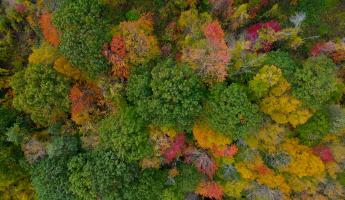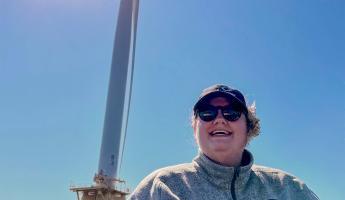

From populating an early conservation database using IBM key punch cards to protecting many thousands of acres of ecologically significant lands in South Carolina, 2023 Distinguished Alumni Award winner Tom Kohlsaat ’73 MFS has always been guided by the conservation needs of the day.
It was the early 1970s, and Richard Nixon was president. The collective consciousness was overwhelmingly focused on cleaning up the environment. Earth Day was established and Congress and the Nixon administration were working together in a bipartisan manner to create the Clean Air Act, the Clean Water Act, the Environmental Protection Agency, and soon after, the Endangered Species Act.
People were eager to do something with purpose, to be “relevant,” Tom Kohlsaat ’73 MFS remembers. At that time, Kohlsaat was working as an electrical engineer for a medium-sized manufacturing company but wasn’t finding the work rewarding. He volunteered with the Neponset Conservation Association in Sharon, Massachusetts, to fight against a planned extension of I-95 through Greater Boston that would have impacted a Black neighborhood in Roxbury and ecologically significant wetlands. The association was also working to clean up the polluted Neponset River. His experience with the conservation association led him to pursue a graduate degree in environmental studies at the Yale School of the Environment.
He soon discovered his niche while attending a terrestrial ecosystems class taught by Professor F. Herbert Bormann, who was Oastler Professor Emeritus of Forest Ecology and best known for helping to discover acid rain. Still an engineer at heart, Kohlsaat says he was hardwired to help find solutions to environmental issues of the day.
“I was a kid in a candy store,” he says. “I was used to looking at problems that you could fix. I started looking in the library about different approaches there might be to fix the environmental situation we were getting ourselves into. I realized through Bormann’s class that it was going to be a bit more complicated than that.”
I started looking in the library about different approaches there might be to fix the environmental situation we were getting ourselves into. I realized through Bormann’s class that it was going to be a bit more complicated than that.”
After graduation, he landed a one-year contract with The Nature Conservancy in South Carolina. TNC was working to create software to help identify top conservation priorities, starting with an emphasis on plants — but first the database had to be populated. Kohlsaat used IBM key punch cards to input the data. The database is still in use today. Now run by NatureServe, a nonprofit conservation organization, it collects and organizes data on rare, threatened, and endangered species and ecosystems from all 50 state heritage programs, along with several Canadian provinces and territories, to identify conservation priorities so that action can be taken. It serves as a key resource to define wildlife conservation priorities and inform policy under the Endangered Species Act.
“You could look up ‘Connecticut’ in NatureServe database and ask, ‘What are the 10 most endangered plants in Connecticut’ and, bang, out they’ll come,” Kohlsaat explains.
After his contract was up, Kohlsaat stayed with TNC working for its South Carolina Wildlife and Marine Resources Department. He successfully lobbied to transform it into the South Carolina Heritage Trust, giving it additional environmental protections as a Heritage Preserve and Sites area under the South Carolina Department of Natural Resources' Heritage Trust Program. Designated preserves and site areas are permanently protected from development. The heritage preserve program was the first of its kind and prompted a movement to create similar programs across the country and throughout the Western Hemisphere.
As part of a national team of volunteers, he also worked to help secure passage of amendments to the Clean Air Act that were needed to eliminate acid rain, a subject he knew well from his work with Professor Bormann.
“It was coming from power plants, and we were able to get the emissions under control by forcing the plants to get all that sulfur out of the air. That felt pretty good, to be present at the creation of that,” he says.
In 2006, Kohlsaat retired from his position as chief of Wildlife Diversity Programs of the South Carolina Department of Natural Resources. Thanks to his leadership, the South Carolina Heritage Trust program now protects more than 70 properties covering almost 100,000 acres of ecologically significant lands throughout the state.
He is still active in conservation, working with the Gills Greek Watershed Association to guide restoration and protection of a degraded urban watercourse. He is also working on efforts to conserve endangered freshwater bivalve mollusks.
Kohlsaat advises YSE students pursing conservation work to have a solid core discipline in addition to a broad environmental science education.
“People need to go deep on a subject, not just skim across the broad spectrum, because the questions can get deep in a hurry. It could be botany, zoology, civil engineering, chemistry … anything that gives you a good core foundation, and then you can build out from that. I hope that’s what’s going on now. An opportunity to go deep," he says.
Meet the Other 2023 Alumni Award Winners

YSE Alumni Award Winner Works to Increase Indigenous Role in Firefighting and Land Management
Forester and federal wildland firefighter Monte Kawahara is working to mitigate the effects of extreme wildfires by focusing on the root causes and partnering with tribal communities. Kawahara’s efforts earned him the Yale School of Environment's 2023 Prospect Street Award.

Champion of the Chesapeake Bay Honored with YSE Alumni Award
As executive director of the Chesapeake Bay Commission, Ann Pesiri Swanson brought together scientists, federal and state legislators, and environmental advocates to forge agreements to protect the health of the largest estuary in the U.S.


